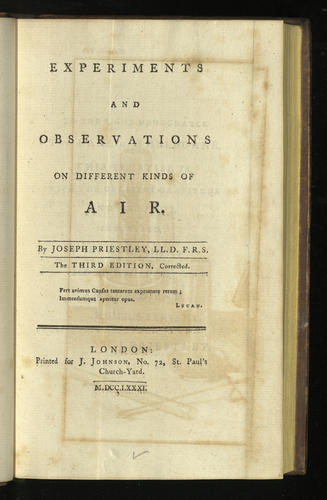-
1 of 253523 objects
Experiments and observation on different kinds of air. Vol. 1. / Joseph Priestley. 1781
RCIN 1090168

Experiments and observation on different kinds of air. Vol. 1. / Joseph Priestley 1781
-
Joseph Priestley was a prolific writer, producing more than 150 different titles throughout his life. Born in Yorkshire, Priestley was a precocious child and intended to become a clergyman, but an illness at a young age left him with a stutter, preventing him from pursuing that career. Unperturbed, the young Priestley studied and wrote on an incredibly diverse range of subjects: from theology and politics to science, history and grammar. He is perhaps best known for this work on the properties of different types of air.
In 1773, Priestley and his family moved to Calne in Wiltshire in order for him to take up a position as companion to William Petty, 2nd Earl of Shelburne. Although the two men did not have much in common, Priestley was able to provide political advice to Shelburne, helped to educate his children, demonstrated experiments to guests and served as the Earl's librarian. He was also able to continue the studies on air that had earned him the Copley Medal, the oldest and most prestigious award of the Royal Society, for his 1772 paper 'Observations on different kinds of air'. The paper was a revelation: it demonstrated the discovery of nitric oxide and anhydrous hydrochloric acid, introduced notions of eudiometry (a traditional method of calculating the composition of gaseous compounds) and introduced early ideas on photosynthesis. In addition, the experiments were very easy to follow, meaning that fellow scientists could continue the work Priestley had started. Continuing these studies at Calne, Priestley published further works on his experiments with air, eventually discovering five other gases: ammonia, nitrous oxide, nitrogen dioxide, sulphur dioxide, and, most significantly, oxygen (or, as he named it, dephlogisticated air).
George III's copy of this work appears to be a "made-up" set: the first volume is of the third edition, published in 1781; the second - containing extensive remarks on the discovery of oxygen - of the second edition, published in 1776; and the third, presumably of the first edition, published in 1777.
Provenance
From the library of George III at Windsor
-
Category